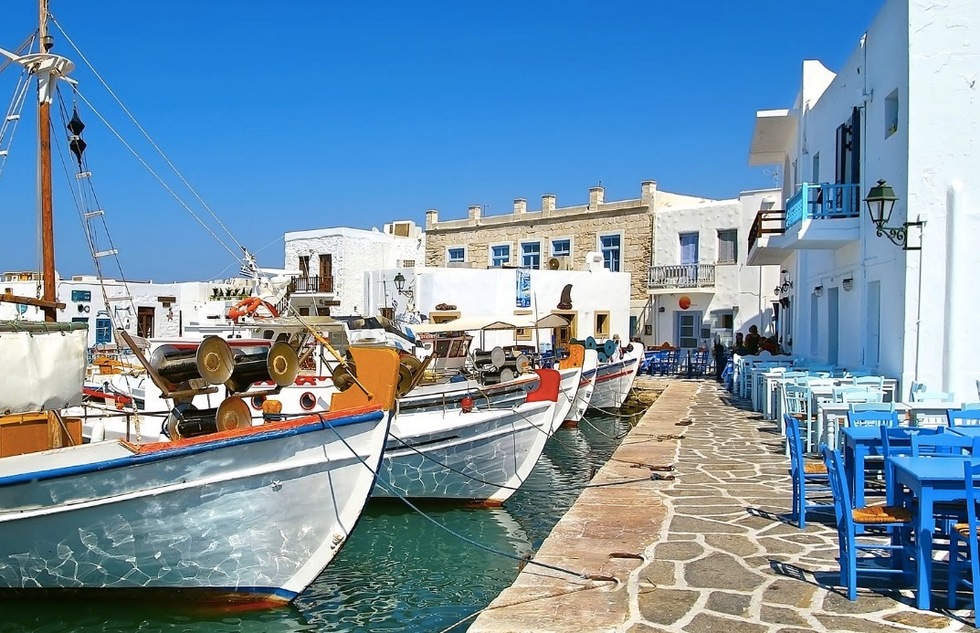11 Best-Kept Travel Secrets of Greece
By Anthony Grant
Travelers to Greece can get so caught up in iconic sights like the Acropolis or Santorini that they tend to overlook Greek attractions and locations that are just as classic, if less widely known. And that’s a shame, because there are few countries that pack as much variety within their borders as Greece. Whether it’s a quirky neighborhood in Athens, a scenic island escape, or an unsung city, Greece has it going on. Stick with us as we lift the lid on Greek travel secrets—like Number 11, pictured.
Paros
When your fancy neighbors go looking for a party island in Greece, they probably end up on Mykonos. But when non-zillionaire Greeks need their party island fix, chances are they’ll choose Paros, almost due south of Mykonos and oozing local flavor. Known for its white marble in antiquity, today the island offers plenty of beachy fun, a hopping bar scene in the main town of Parikia (where the ferries come in from Athens), and plenty of Cycladic charm in Naoussa, on the island’s northern side.
Attica and the Athens Riviera
When you think of Athens beaches probably aren’t what comes to mind first, but that doesn’t mean they’re not there. You just have to look a little harder to find them. Fortunately, the greater Athens area has an excellent, modern transportation network putting a day at the beach within easy reach. Take the metro and then a city bus to the beaches and coves that extend just south of the Athens suburb of Glyfada and all the way down to Cape Sounion.
Milos
Little Milos may be the most underrated of the Cycladic Islands, but in terms of spectacular scenery it is second only to Santorini. Like that island, Milos is volcanic, and that geology plays itself out to colorful effect on the islands numerous fine beaches—there are about 70. At Sarakiniko, the volcanic landscape goes bleach-white, forming a stark contrast to the cobalt blues of the Aegean Sea. The main harbor town is Adamantas and yes, this where the Venus de Milo comes from.
Athens: Monastiraki and Psirri
After visiting the Acropolis, most tourists wander around the Plaka because it’s the neighborhood literally at the bottom of the hill. But Plaka is largely cluttered with tacky souvenir shops. The adjoining neighborhoods of Monastiraki and Psirri (just north of Plaka) are where real Athenians go eat, drink and shop. You’ll find great tavernas with better prices, plenty of cafes, and lots of vibrant street art, too.
Kythera
There are plenty of pretty islands in the Mediterranean, but only one where Aphrodite was born, and that’s Kythera (she washed ashore in Cyprus, but that’s another story). The island is not formally a part of any named Greek island chain, but it is located at a strategic point off the southernmost part of the Peloponnese. For centuries it was favorite haunt among pirates, and to this day, unspoiled natural landscapes and pristine beaches are the big draw.
Iraklion
Iraklion (also written as Heraklion), the administrative capital of Crete, is mostly known as the place where cruise ships stop so passengers can make shore excursions to the (overcrowded and underwhelming) ruins of Knossos. That’s a pity, because the town itself is rich with history—such as Koules, a seaside port built by the Venetians—and brimming with great restaurants and cafés. Plus, the Archaeological Museum is the world’s leading repository of Minoan art, and it recently emerged from an extensive renovation.
Chania
Like Heraklion, Chania lies on the northern coastline of Crete, but it’s more to the west. It’s also the more picturesque of the two towns, with the Venetian architectural heritage particularly strong in and around the harbor area. The old town can get a little crowded in summer, but positioning yourself in Chania puts you within easy reach of some expansive beaches farther west.
Thessaloniki
Athens will always be Greece’s Numero Uno, but Thessaloniki makes a strong showing as the country’s second-largest city. The capital of the Greek Macedonian region, Thessaloniki boasts a robust cultural life, with a popular international film festival and events all year long. You can explore ancient Roman ruins and lose yourself in the justly famous Museum of Byzantine Culture, where you'll find the world's specimens from the period.
Athens: Secret Museums
Most tourists in Athens make a beeline for the either the Acropolis Museum or National Archaeological Museum, and it’s true that each is fabulous. But if they are the heavy hitters in terms of the capital’s culture, they tend to obscure some real museum gems that are definitely worth checking out. These include the jewel-like Museum of Cycladic Art (pictured) and Benaki Museum, both in the Kolonaki district, and the captivating Numismatic Museum, an astounding coin collection in an even more spectaular mansion that belonged to archaeologist Heinrich Schliemann.
Messene
Yes, its name is confusingly similar to that of the Italian province and city of Messina, in Sicily. Now that we’ve got that out of the way, remember to put a little Messene into your next Grecian odyssey. Why? Because this lush southwestern pocket of the Peloponnese is home to lively Kalamata (of olive fame—you'll eat many), fascinating ancient ruins, and some truly heart-stopping stretches of coastal scenery like this one.
Aegina
Suppose you find yourself with an extra day in Athens: not quite enough for a break to Mykonos or other Aegean island, but too tempting to not make a breezy break from the pavement. Try Aegina: it’s just 35 minutes from Piraeus port by hydrofoil and a world away from the urban congestion. The first must is a visit to the Temple of Aphaia; amazingly well-preserved. You’ll feel like you’re on a private tour of the Parthenon. The second thing is pistachios: Aegina is famous for ‘em, so stock up. And of course, for those picturesque coastlines that no place does quite as well as Greece can.

















